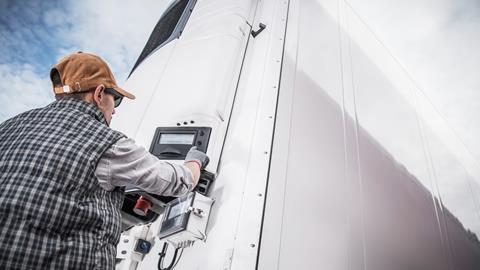Refrigerated trailers can produce more than double the emissions of nitrogen oxides (NOx), five times the particulate mass (PM) and up to four hundred times the particle number, compared with emissions from the Euro 6 HGVs pulling them, according to a major study by the Zemo Partnership.
Despite there being around 47,500 auxiliary transport refrigeration units (auxTRUs) on the UK’s roads, rigorous emission standards applied to HGV engines do not currently apply to these vehicles, as these are regarded as non-road mobile machinery (NRMM).
However the government is now turning its attention to these engines, aided by a major study by Zemo, which is funded by the DfT.
Taking into consideration the 2019 Non-Road Mobile Machinery (NRMM) regulations, which started to impose limits on some auxTRU emissions from January 2019, the study also looked at the emission rates of both pre-2019 and post-2019 units.
Reporting on the results of the first phase of the study, Zemo Partnership revealed a single diesel auxTRU fitted to a Euro-6 HGV and operating in typical city or urban conditions, would:
• Consume around 10% of the fuel (slightly more if made pre-2019).
• Produce about 10% of the GHG emissions (slightly more if made pre-2019).
• Produce at least double (2x) the NOx if pre-2019 and at least 50% more (1.5x) if post-2019.
• Emit at least five times (5x) the particle mass (PM2.5) if pre-2019 and around triple (3x) if post-2019.
• Emit about 400 times (400x) the number of particles if pre-2019 and around 300 times (300x) if post-2019.
The research also found that very hot weather will substantially increase the NOx, particle mass, particle number, and fuel consumption of auxTRUs.
![Zemo NOx Production Rates (Temperatures)[70615]](https://d2cohhpa0jt4tw.cloudfront.net/Pictures/480xany/9/3/3/16933_zemonoxproductionratestemperatures70615_374249.jpg)
The report noted: ”Fortunately, many alternative systems for transport refrigeration are now coming to market, (partly driven by the policy changes to red diesel treatment) including solar powered trailers and electric fridges with zero pollutant emissions in use.”
It added that the next stage of the study will extend the work to consider the refrigerated van sector and investigate the energy and emissions of alternative technologies, to understand what can be done to reduce the environmental impacts of auxTRUs and from other ancillary engine uses, such as road sweepers. The final report is due in November 2024.
![Zemo NOx Production Rates (Pre-2019 vs Post-2019)[70614]](https://d2cohhpa0jt4tw.cloudfront.net/Pictures/480xany/9/3/4/16934_zemonoxproductionratespre2019vspost201970614_551683.jpg)
Zemo research co-author Emily Stevens said: “It’s clear that auxiliary transport refrigeration units and other ancillary engines can significantly add to transport-linked emissions of greenhouse gases as well as those of local pollutants.
”The level of these emissions can be disproportionately large compared with those from the vehicle’s engine.
“As this study makes clear, there are opportunities for achieving significant emissions reductions in this area.
”The next stage of our study will identify the most effective ways to achieve these reductions.”
Zemo’s report HGV Auxiliary Engines: Baseline auxTRU testing and modelling of UK impacts can be downloaded here.

















